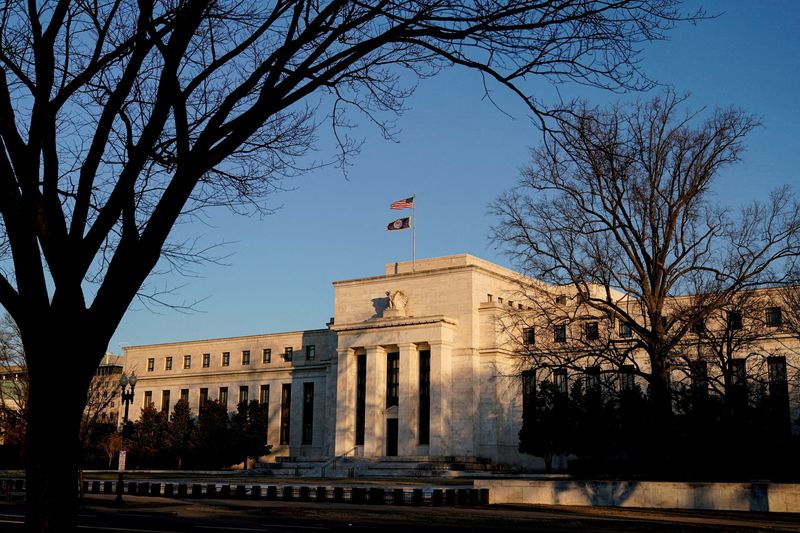Sooner or later, Fed may need technical tweaks for rate control toolkit

FILE PHOTO: The Federal Reserve building is seen in Washington, U.S., January 26, 2022. REUTERS/Joshua Roberts
By Michael S. Derby
NEW YORK (Reuters) — If the Federal Reserve really wants to move some of the mountain of cash now residing in its overnight reverse repo facility, technical changes in its rate control toolkit would do the trick, some central bank watchers say.
The tweaks they envision are not shifts in the federal funds target rate, the central bank’s main tool for influencing the economy to achieve its job and inflation goals. Instead, it comes down to changing the setting of two other rates relative to the fed funds range in a way that departs from recent practice but could nudge money market funds to seek another home for some of the $2 trillion a day now deposited at the Fed.
Those two rates exist to keep the market-driven fed funds rate in the desired range. One, called the reverse repo rate, sets a floor underneath short-term rates, while another, which pays deposit-taking banks to park cash at the Fed, sets the high end.
The reverse repo facility takes in cash from money market funds and other eligible firms, and currently pays an annualized rate of 4.30% for overnight loans of cash, compared to the current federal funds rate range of between 4.25% and 4.5%.
The Fed is widely expected to raise the target rate to 4.5% to 4.75% at Wednesday’s Federal Open Market Committee meeting. If it sticks to recent practice, it will raise the reverse repo and the interest on reserve balances rate, now at 4.4%, by the same 25 basis point increment.
TWEAK NOW OR LATER
But some Fed watchers say the central bank has a choice, one it could take this week or later. And if it does do a tweak now, it would be unlike past tweaks. Those adjustments happened purely to ensure control of the fed funds rate, while this sort of move would speak more directly to bigger monetary policy concerns around managing the size of its $8.5 trillion balance sheet.
The reverse repo facility has seen sustained inflows of over $2 trillion per day since last June and has failed to contract as many policymakers expected. On many days, the facility offers the highest overnight rate available to many firms, so it’s a no brainer for them to skip the private market and park cash at the Fed.
“If [policymakers] wanted a small balance sheet, they could reduce the overnight [reverse repo rate]” relative to the federal funds rate “and that would drive money out of overnight [reverse repo,] drive it into reserves,” which would in turn give them more space to cut the size of their balance sheet, said William English, a finance professor at the Yale School of Management who is formerly a top Federal Reserve staff member.
Given the strong chance of a quarter percentage point increase Wednesday, Bill Nelson, who is also a former top Fed staffer and now serves as chief economist with Bank Policy Institute, said the Fed could once again make the reverse repo rate match the bottom end of the new federal funds rate range, with the interest on reserves rate matching the top.
Doing this change now «would probably be easier to explain and less newsworthy than making the change at some other time or to some other configuration,” Nelson said.
The Fed has tweaked the relative rate settings several times since adopting its so-called abundant-reserves approach after the financial crisis, and pursuing Nelson’s suggestion would mark the first time since June 2018 that the interest on reserves and reverse repo rates were set to match the upper and lower bounds of the fed funds range.
Some in the market fear rate control toolkit tweaks might create unneeded headaches if done too aggressively. Scott Skyrm, of money market trading firm Curvature Securities, warned that should the Fed straight up hold the reverse repo rate at 4.3%, which would be unlikely, «it would create a severe dislocation in overnight rates…Imagine $2 trillion entering the repo market over a course of a few days.”
Instead, Skrym expects the Fed to bump the two rates up by the same amount as the federal funds rate on Wednesday, in line with its recent practice.



